Kathleen
Forum Replies Created
Viewing 12 posts - 1 through 12 (of 12 total)
-
KathleenParticipantI did enjoy the Joy of Birdwatching class! It reminded me of many things from my Ornithology class 49 years ago. It taught me many new things that I took in gladly. It made me think about the future, and how "Silent Spring" can happen if we leave things the way they are. But if it is up to me, that sad morning will not happen. I'm still struggling with e-Bird.in reply to: Activities: Helping Birds in Your World #726051
-
KathleenParticipantHelping Birds in Your World Activity 2: Think about the Seven Simple Actions to Protect Birds. Which are you already doing? Could you practice any of them more extensively, or start trying more of them? What other actions can you think of that could help birds? Share in the discussion. Activity 3: Have you noticed bird populations changing over your lifetime? Share your observations in the discussion. I think I must add Activity 3, since I am 73, and have lived in so many places [Minnesota, Nebraska, South Dakota, Colorado, New Mexico, Sweden and Washington state]. Activity 2 helped me to make some decisions, as well as decisions I made long ago. While in MN a beautiful oriole hit our corner window, and was killed. I made a decision then to put some full-sized adhesive birds on our windows, and not one more crashed. I used them in all large windows in every house. We’ve always planted native [as well as some roses, marigolds and food plants], but the Minnesota plan to pay to plant bee-loving plants seems like an idea that’s good for birds as well. We have used no pesticides since we went to NM. That meant listening for tomato worms and plucking them off. We are now [state mandated] using only paper bags and re-re-re-using plastics. Paper bags are great kindling for camp fires and fireplace. We started with Christmas Bird Count 53 years ago in the Black Hills of SD. It was -10° F and about 2 feet of snow! The other 2: cats and bird-friendly coffee, well we don’t have cats, but we drink coffee. Thanks for the idea! Activity 3 I’ve been thinking about this for a while. As a girl, my favorite summer place was the lake in northern Minnesota. There wasn’t a bald eagle or a loon to be seen. But there were other birds galore! Eastern Phoebe woke me every morning, Purple Martins [didn’t hurt my aunt had a house for them], American Goldfinch [black seeds attracted them], Great Blue Herons [Shy-poke as mom called them], gulls decorated the docks, mergansers [with lots of little ones] and a bird I loved but I never heard again after about 7 years, we called it the xylophone bird because its song sounded like that, and because we didn’t know the name. Thanks to hard work by the rangers, I saw the first Bald Eagle, about five years ago. My cousin hears loons in spring and fall. Martins, Goldfinches, Herons, gulls, and mergansers are still there, but the Eastern Phoebes seem to be gone, and the little xylophone bird seems to have gone for good.in reply to: Activities: Helping Birds in Your World #726049
-
KathleenParticipantKeeping Track of Your Birdwatching Activity 1: Spend some time practicing taking field notes while observing birds. Try structuring your notes using the bird ID strategies you learned about in this course. You could use pictures, words, or some combination of them. Are your field notes helpful for you in later identifying the birds you saw? Share your experiences in the discussion. I fudged a little on this one. I used 30-year old field notes rather than doing new ones. I wanted to see how my notes helped me [or didn’t help me], and how I could improve the process. Turns out it was OK, but it could be improved. My first list was just after moving here. Mon. 12/31/90 Red-shafted flicker (on the ground); Robins (LOTS); Steller’s Jay (chasing squirrels); Slate colored and Oregon juncos; Downey woodpecker (male, eating pork fat); Golden-crowned kinglets (many, male and female). What time was it? How long did I watch? Where did I watch? Flicker-what was he doing on the ground-eating? They are usually in/on the trees. Were there 2 of them? Juncos-Still sorting them out! Robins-Were they flying, foraging, playing? Since I wrote jay [not jays] it must have been one-chasing a squirrel. Downey woodpecker-I doubt if he’d share. GC Kinglets-Hard to count, but I managed to note there were male and female-they weren’t flirting or mating-they were looking for and finding food. I learned a lot from 30-year old notes! A bit of preparation would be good: Time [start & stop], place. Then there was what they were doing: Eating, flying, foraging. Most were eating [time of year]. Name: I nailed that! Day of the week, date: Nailed both! Weather: Nice, but not a requsite. Food: Seeds, tree bugs, earth bugs, small animals, fish, whatever, flying bugs… Habitat: Never knew flickers spent so much time on the ground!in reply to: Activities: Keeping Track of Your Birdwatching #725411
-
KathleenParticipantI agree with you! I'm not tossing my RT Peterson either. We got it about 1966, and we have lots of notes in it...from LP Michigan, to Minnesota, to South Dakota, to New Mexico, to Colorado, to our 30 year home in Bellevue, Washington (and one year in Sweden)!in reply to: Activities: Keeping Track of Your Birdwatching #724953
-
KathleenParticipant
@Sylvester Although bird look like they are building nests, sometimes they "try 2-3 out" at about the same time. It could be what happened to you. Take a look around, maybe she chose one close, but not so visible.
in reply to: Activities: Keeping Track of Your Birdwatching #724949 -
KathleenParticipantHABITATS Activity 1: Think of two different habitats near you where you might go birding. Maybe it’s a park and a more urban area, or a field and the edge of a pond. Visit each one and see if you notice different birds in each habitat. Tell us what you find in the discussion. Mercer Slough Nature Park Trails-4:00 PM Birds Seen: Stellers Jay, Chestnut-backed Chickadee, Black-headed Grosbeak (immature) Habitat: Forested, with small ponds and creeks-Slough Results: Leafy trees got in the way. Sun angle was bad. We identified Stellers Jay and Chickadee by their calls. We had to look up the Grosbeak in the book, which had no immature. After coming home we looked in another book and made a sure identification. All of these birds were in the leafy tops of the trees. Sweyolocken Boat Launch-4:45 PM Birds Seen: Bald Eagle, Common Crows Habitat: Open water and Boat Marina—Lake Washington Results: Easy to identify these two birds! The eagle was clearly fishing as he was patrolling the waters off the boat docks. The crows were checking out the garbage spots for any food. We looked for cormorants, any ducks-didn’t see any! Decided to try Newcastle Beach Park. Newcastle Beach Park-10:30-11:30 AM Birds Seen: Robins, Bald Eagle (adult and juvenile), Fox Sparrow, Chestnut-backed Chickadee Habitat: Open water and Forested Shoreline-Lake Washington Results: Had seen ducks and cormorants here before, and were optimistic. We tried the shore first, and spotted the adult Bald Eagle, with the immature in hot pursuit (for food) over the water. There was evidence of geese everywhere, but no geese in sight. Not cormorants, ducks either-not one! Then we went to the forested shoreline-we saw a sparrow, chickadee, and robins in the brush, but experienced lots more mosquitoes than birds! Conclusion: Come any other season than summer-before leaves are out. Birds also will not have migrated and will have more diversity.in reply to: Activities: Exploring Bird Habitats #719956
-
KathleenParticipantActivity 2: Watch birds at a bird feeder—your own, at a nature center, or on feeder cams (the Cornell Lab Feeder Cam or the Panama Fruit Feeder Cam). Pay close attention to how different species use slightly different techniques for eating. How much time do they spend on the feeder? Do they take one seed at a time, or multiple seeds? Share what you see in the discussion. I watched our regulars at our bird feeder, as we have many Chestnut-backed Chickadees & Oregon Juncos living in the juniper trees around our lot. Then just days ago the House Finch came to call. Here are the results I saw: Chestnut-backed Chickadees- # of seeds=1. Amount of time=about 1 second. Fly away to a nearby tree, while another Chickadee flies in & repeats the steps. It’s like they are on a fast merry-go-round! Oregon Juncos- # of seeds=3-4. Amount of time=as much time as it takes to find 3-4 of their favorite seeds. Fly away to a nearby tree, while another Junco flies in & repeats the steps. It’s like they are on a slow merry-go-round! House Finch-# of seeds=as many as they can cram in their bills (males first). Amount of time=As much time as it takes to find their favorite seeds to fill their bill. Fly away or eat the seeds there, scaring off the other birds until they are full.in reply to: Activities: Noticing Behaviors #716625
-
KathleenParticipantBirdwatching Through the Seasons Activity 2: Using Merlin’s “Likely Birds” feature and/or range maps in field guides, explore birds that are found in your area. Choose three species that are year-round residents, and three that only live in your area for part of the year. Have you seen any of them before? Share what you find in the discussion. I checked my range maps in my field guides against Merlin. I found many of our birds extended to a larger area for year around in Merlin than in my older field guides. I checked these year around birds, since we see them nearly every day: Oregon Junco, Bewick’s Wren, and Anna’s Hummingbird. I checked these for migrants: Bullocks Oriole, Fox Sparrow, and Ruby-crowned Kinglet. I have seen all six before, but the second three only periodically. The Bullocks Oriole we just spotted last week [first sighting, and mistook him at first for a Varied Thrush]. We expect to see the pair off and on through the summer breeding season [Apr-Sep]. The last time we saw a Fox Sparrow was early spring, probably late Mar or early Apr. This large sparrow will come back in the fall to mix with the other juncos and wrens and kinglets to have a cozy winter [non-breeding season]. A hard one to identify is the Ruby-crowned Kinglet, which shares the Fox Sparrow’s migration timing. This tiny cutie arrives in about Sep to share its non-breeding season and takes off about Apr to breed and raise their tiny young ones in northern Canada and Alaska.in reply to: Activities: Different Seasons, Different Birds #708610
-
KathleenParticipantActivity 2: Use Merlin’s “Most Likely” species feature to find out what birds you are likely to see locally today. If you can, go out and try to find some of them. Be sure to listen to their call and song on Merlin. Maybe it’s a song you’ve heard before, but you didn’t know who made it! First I checked with Merlin to see how many birds I expected to see. 178! I looked through and waterfowl, seabirds, wading-birds, chicken-like birds, shorebirds, owls & parrots, I was able to eliminate! That left only songbirds, raptors, woodpeckers, and hummingbirds. That's plenty! Because I am stroke disabled, and Covid-19 restricted, I looked only at the area around the house. I started in the back, with the bird feeders and evergreens, tall and short. It's Washington state and therefore it was raining...all day. The first thing I saw was a Stellers Jay, picking around in the grass. He didn't stay very long...he was alone. The second thing I heard and saw, was the song of the Bewick's Wren, and sure enough, two came up on the patio and searched for nesting material! One came hopping up to the door and peeked in with his bill full. Then they flew away. A bit later I finally saw a small Anna's Hummingbird come for a taste of our humming-juice. He didn't stay long either, but two Black-Capped Chickadees came one at a time and flew quickly back to the trees to eat, while the other one flew up to get her portion. Eventually they chased each other away, presumably in a courting chase. I looked down from the feeders, and what did I see, but a Spotted [we call them Rufous-sided] Towhee gobbling up some of the seeds the small birds had dropped! I raised my binoculars excitedly, and of course he flew off. Before I went to the road side of the house, I was looking for some Dark-eyed Juncos which Merlin said were the only kind in the neighborhood. I saw lots of Oregon Juncos, but no Dark-eyes. I guess the Oregons are sub-species, but they sure aren't in our yard! I had heard crows in the front yard all day, so I was eager to see if there were any kind but Common Crows. It seems the only kinds are common and a few Ravens on any one day. I am trying to learn how to whistle a few of the songbirds' songs, and I've gotten the Junco's down pretty well, the crow's isn't a whistle it's throaty, but now I'm working on a few of the woodpeckers! We'll see!in reply to: Activities: Local Bird Exploration #705214
-
KathleenParticipantActivity 4: Pick your favorite bird, and see if you can describe it using at least three of the bird ID strategies (size and shape, color pattern and markings, behavior, habitat and range, and sounds). Share your description in the discussion. One of my favorite birds is one I see 3-4 times a year-The Pileated Woodpecker. He is not quite as big as a crow [which we have lots of] but I look to see if it's "Woody" every time a big shadow goes over. He has a crest--crows don't. He [and she] come for one thing--a felled conifer that we left for a nurse log. They settle in and begin to drill, and the pieces of wood start flying, and the bugs start disappearing. They walk up the tree to peck, or stand on the ground, as you can see. They often come together as a pair, something I really like. Stellars Jays do too. When they call you can hear them throughout the neighborhood. They are shy but I got some pictures of them.


 in reply to: Activities: Bird ID Practice #703326
in reply to: Activities: Bird ID Practice #703326 -
KathleenParticipant
 Activity 3
We went out to the ocean during the winter to see what birds we could see. We saw a relative (Pacific Loon) of my favorite the Common Loon. Being from Minnesota I fell in love early with our State Bird, and I would hear it sometimes during the night singing one of it's three beautiful songs. I never forgot those nights, and they are back at the lake now, and I can hear them again. I can't get a picture, they are so shy.
Activity 3
We went out to the ocean during the winter to see what birds we could see. We saw a relative (Pacific Loon) of my favorite the Common Loon. Being from Minnesota I fell in love early with our State Bird, and I would hear it sometimes during the night singing one of it's three beautiful songs. I never forgot those nights, and they are back at the lake now, and I can hear them again. I can't get a picture, they are so shy.
 When we went to Lincoln, NE, for my aunt's funeral, I was terribly sad. I thought I would visit a museum to feel better. I did, and it helped, but as I pulled out of the parking lot, I thought I saw a crumpled paper bag in front of the museum. I kept watching, and soon realized it wasn't a bag but a Red- Tailed Hawk greedily eating a red squirrel. I stopped & got my camera and began taking pictures. He continued eating. I quietly exited the car & continued taking pictures with my long lens. After he finished his meal he flew off to watch for another red squirrel. It was as if the hawk told me good bye from my aunt.
When we went to Lincoln, NE, for my aunt's funeral, I was terribly sad. I thought I would visit a museum to feel better. I did, and it helped, but as I pulled out of the parking lot, I thought I saw a crumpled paper bag in front of the museum. I kept watching, and soon realized it wasn't a bag but a Red- Tailed Hawk greedily eating a red squirrel. I stopped & got my camera and began taking pictures. He continued eating. I quietly exited the car & continued taking pictures with my long lens. After he finished his meal he flew off to watch for another red squirrel. It was as if the hawk told me good bye from my aunt.
 This little guy came to visit us the minute we put the hummingbird feeder out. I think it is an Anna's. She stayed on through the fall and all winter. When it got cold, we'd have two feeders ready in case one froze up. We'd run out grab the frozen one and put out the warm one up from the kitchen. The minute we's turn our back to go in, she was there, sucking away. We think her great-great-great-great grandchildren are still with us, although not as unafraid as she was, and they stay year around, just like her. in reply to: Activities: Exploring Birds #699477
This little guy came to visit us the minute we put the hummingbird feeder out. I think it is an Anna's. She stayed on through the fall and all winter. When it got cold, we'd have two feeders ready in case one froze up. We'd run out grab the frozen one and put out the warm one up from the kitchen. The minute we's turn our back to go in, she was there, sucking away. We think her great-great-great-great grandchildren are still with us, although not as unafraid as she was, and they stay year around, just like her. in reply to: Activities: Exploring Birds #699477 -
KathleenParticipantAre you close to Bosque del Apache? That was our favorite place while living in ABQ!in reply to: Activities: Exploring Birds #698451
Viewing 12 posts - 1 through 12 (of 12 total)

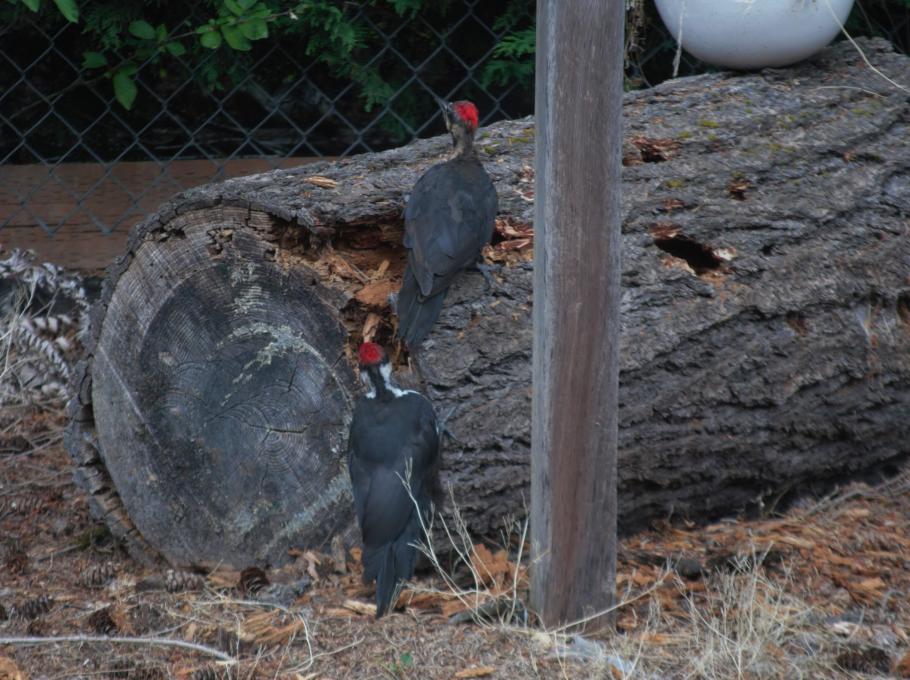
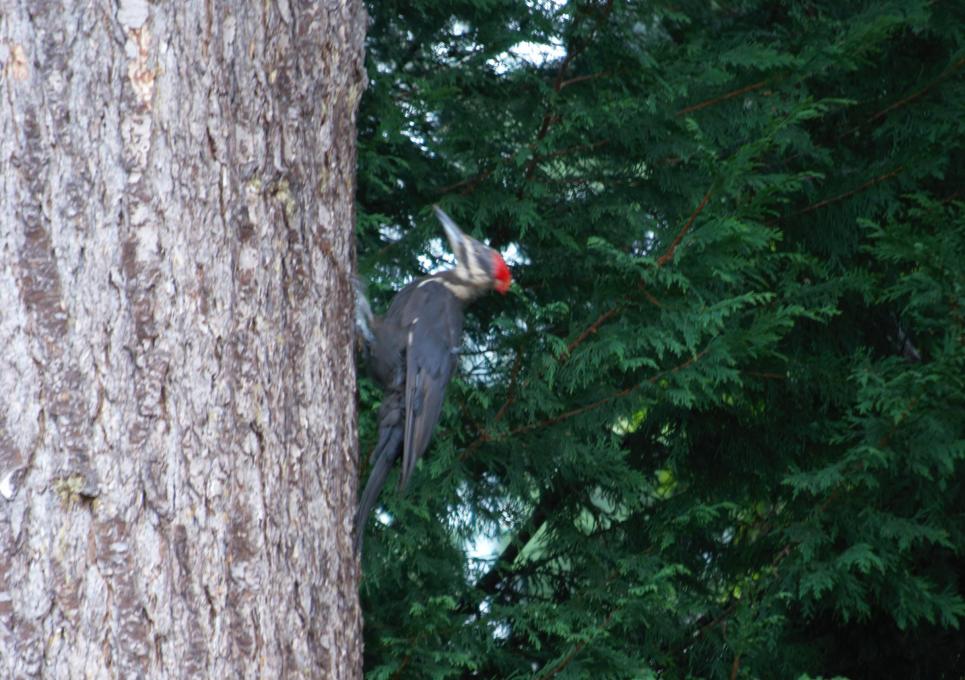
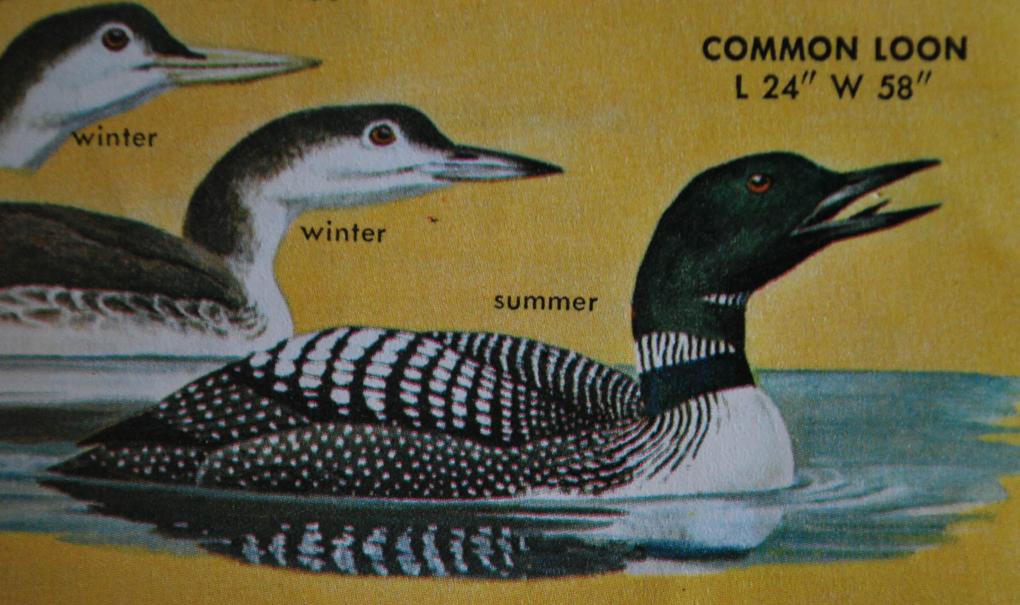 Activity 3
We went out to the ocean during the winter to see what birds we could see. We saw a relative (Pacific Loon) of my favorite the Common Loon. Being from Minnesota I fell in love early with our State Bird, and I would hear it sometimes during the night singing one of it's three beautiful songs. I never forgot those nights, and they are back at the lake now, and I can hear them again. I can't get a picture, they are so shy.
Activity 3
We went out to the ocean during the winter to see what birds we could see. We saw a relative (Pacific Loon) of my favorite the Common Loon. Being from Minnesota I fell in love early with our State Bird, and I would hear it sometimes during the night singing one of it's three beautiful songs. I never forgot those nights, and they are back at the lake now, and I can hear them again. I can't get a picture, they are so shy.
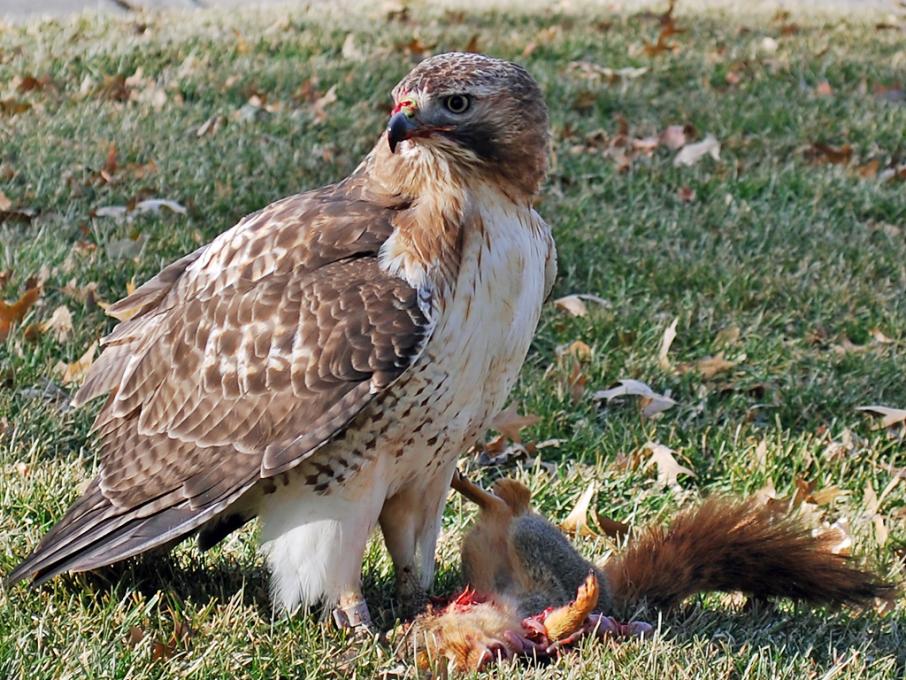 When we went to Lincoln, NE, for my aunt's funeral, I was terribly sad. I thought I would visit a museum to feel better. I did, and it helped, but as I pulled out of the parking lot, I thought I saw a crumpled paper bag in front of the museum. I kept watching, and soon realized it wasn't a bag but a Red- Tailed Hawk greedily eating a red squirrel. I stopped & got my camera and began taking pictures. He continued eating. I quietly exited the car & continued taking pictures with my long lens. After he finished his meal he flew off to watch for another red squirrel. It was as if the hawk told me good bye from my aunt.
When we went to Lincoln, NE, for my aunt's funeral, I was terribly sad. I thought I would visit a museum to feel better. I did, and it helped, but as I pulled out of the parking lot, I thought I saw a crumpled paper bag in front of the museum. I kept watching, and soon realized it wasn't a bag but a Red- Tailed Hawk greedily eating a red squirrel. I stopped & got my camera and began taking pictures. He continued eating. I quietly exited the car & continued taking pictures with my long lens. After he finished his meal he flew off to watch for another red squirrel. It was as if the hawk told me good bye from my aunt.
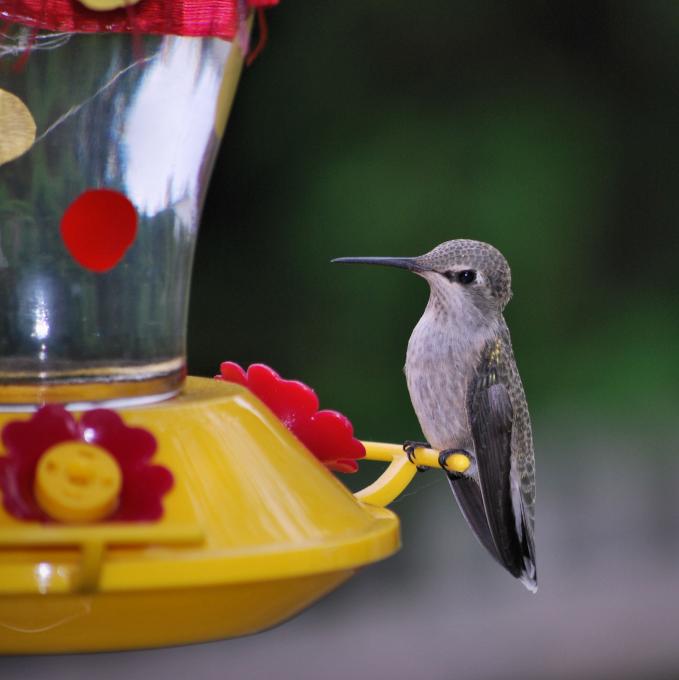 This little guy came to visit us the minute we put the hummingbird feeder out. I think it is an Anna's. She stayed on through the fall and all winter. When it got cold, we'd have two feeders ready in case one froze up. We'd run out grab the frozen one and put out the warm one up from the kitchen. The minute we's turn our back to go in, she was there, sucking away. We think her great-great-great-great grandchildren are still with us, although not as unafraid as she was, and they stay year around, just like her.
This little guy came to visit us the minute we put the hummingbird feeder out. I think it is an Anna's. She stayed on through the fall and all winter. When it got cold, we'd have two feeders ready in case one froze up. We'd run out grab the frozen one and put out the warm one up from the kitchen. The minute we's turn our back to go in, she was there, sucking away. We think her great-great-great-great grandchildren are still with us, although not as unafraid as she was, and they stay year around, just like her.